Bio-Optical Characterization and Ocean Colour Inversion in the Eastern Lagoon of New Caledonia, South Tropical Pacific
Abstract
1. Introduction
2. Materials and Methods
2.1. Study Area
2.2. Oceanographic Campaign
2.3. Biogeochemical and Bio-Optical Properties
2.4. Radiometric Measurements
2.5. Bio-Optical Algorithms
3. Results and Discussion
3.1. Environmental and Bio-Optical Characterization
3.2. In Situ Radiometry
3.2.1. Radiometric Comparisons
3.2.2. Closure Experiment
3.3. Bio-Optical Algorithm Evaluation
3.3.1. Chlorophyll a Concentration
3.3.2. Inherent Optical Properties
3.3.3. Water Turbidity
4. Conclusions and Final Remarks
Author Contributions
Funding
Acknowledgments
Conflicts of Interest
Abbreviations
| 0− | Just below the surface |
| 0+ | Just above the surface |
| aphy* | Phytoplankton absorption coefficient normalized by Chla, m2/mg |
| acdom | CDOM absorption coefficient, m−1 |
| adg | Detritus absorption coefficient, m−1 |
| anap | Non-algal particulate absorption coefficient, m−1 |
| ap | Particulate absorption coefficient, m−1 |
| aphy | Phytoplankton absorption coefficient, m−1 |
| aw | Pure seawater absorption coefficient, m−1 |
| bbp | Particulate backscattering coefficient, m−1 |
| bw | Pure seawater backscattering coefficient, m−1 |
| CDOM | Coloured dissolved organic matter |
| Chla | Chlorophyll a concentration, mg/m³ |
| Ed | Downwelling solar irradiance, W·m−1 |
| ELNC | Eastern Lagoon of New Caledonia |
| Kd | Diffuse attenuation coefficient, m−1 |
| Lu | Upwelling radiance, W·m−2·sr−1 |
| Lw | Water leaving radiance, W·m−2·sr−1 |
| R2 | Coefficient of determination |
| Rrs | Remote sensing reflectance (just above surface), sr−1 |
| RrsS | Remote sensing reflectance from Satlantic radiometer, sr−1 |
| RrsT | Remote sensing reflectance from TriOS radiometer, sr−1 |
| Sdg | Spectral slope of adg, nm−1 |
| Sbbp | Spectral slope of bbp, nm−1 |
| Scdom | Spectral slope of acdom, nm−1 |
| Snap | Spectral slope of anap, nm−1 |
| β | Volume scattering function, m−1 sr−1 |
| λ | Wavelength, nm |
References
- NOAA’S. Coral Reef Conservation Program: Coastal Protection. 2011. Available online: http://coralreef.noaa.gov/aboutcorals/values/coastalprotection/ (accessed on 22 May 2014).
- Payri, C.; Benzoni, F.; Houlbreque, F. Le blanchissement des coraux: L’épisode de 2016 en Nouvelle Calédonie. l’ENA hors les murs 2017, 470, 13–16. [Google Scholar]
- Hoegh-Guldberg, O.; Mumby, P.J.; Hooten, A.J.; Steneck, R.S.; Greenfield, P.; Gomez, E.; Harvell, C.D.; Sale, P.F.; Edwards, A.J.; Caldeira, K.L.; et al. Coral reefs under rapid climate change and ocean acidification. Science 2007, 318, 1737–1742. [Google Scholar] [CrossRef] [PubMed]
- Diaz-Pulido, G.; Gouezo, M.; Tilbrook, B.; Dove, S.; Anthony, K.R.N. High CO2 enhances the competitive strength of seaweeds over corals. Ecol. Lett. 2011, 14, 156–162. [Google Scholar] [CrossRef] [PubMed]
- Courtial, L.; Ferrier-Pages, C.; Jaquet, S.; Houlbreque, F. Effects of temperature and UVR on organic matter fluxes and the metabolic activity of Acropora muricata. Biol. Open 2017, 6, 1190–1199. [Google Scholar] [CrossRef] [PubMed]
- Andrefouët, S.; Payri, C.; Van Wynsberge, S.; Lauret, O.; Alefaio, S.; Preston, N.G.; Yamano, H.; Baudel, S. The timing and the scale of the proliferation of Sargassum polycystum in Funafuti Atoll, Tuvalu. J. Appl. Phycol. 2017, 29, 3097–3108. [Google Scholar] [CrossRef]
- IUCN. The Lagoons of New Caledonia: Reef Diversity and Associated Ecosystems (France); Evaluation Report; World Heritage Committee IUCN: Gland, Switzerland, 2008; pp. 43–54. [Google Scholar]
- Dupouy, C.; Lefèvre, J.; Wattelez, G.; Martias, C.; Andreoli, R.; Lille, D. Satellite survey of lagoons and reefs. In Récifs Calédoniens; IFRECOR: Roubaix, France, 2018. [Google Scholar]
- Dupouy, C.; Röttgers, R.; Tedetti, M.; Martias, C.; Murakami, H.; Doxaran, D.; Lantoine, F.; Rodier, M.; Favareto, L.R.; Kampel, M.; et al. Influence of CDOM and particle composition on ocean color of the Eastern New Caledonia Lagoon during the CALIOPE cruises. In Ocean Remote Sensing and Monitoring from Space; 92610M; International Society for Optics and Photonics: Bellingham, WA, USA, 2014; Volume 9261. [Google Scholar] [CrossRef]
- Martias, C.; Tedetti, M.; Lantoine, F.; Jamet, L.; Dupouy, C. Characterization and sources of colored dissolved organic matter in a coral reef ecosystem subject to ultramafic erosion pressure (New Caledonia, Southwest Pacific). Sci. Total Environ. 2018, 616–617, 438–452. [Google Scholar] [CrossRef] [PubMed]
- Eakin, C.M.; Nim, C.J.; Brainard, R.E; Aubrecht, C.; Elvidge, C.; Gledhill, D.K.; Muller-Karger, F.; Mumby, P.J.; Skirving, W.J.; Strong, A.E.; et al. Monitoring coral reefs from space. Oceanography 2010, 23, 118–133. [Google Scholar] [CrossRef]
- Mouw, C.B.; Greb, S.; Aurin, D.; DiGiacomo, P.M.; Lee, Z.; Twardowski, M.; Binding, C.; Hu, C.; Ma, R.; Moore, T.; et al. Aquatic color radiometry remote sensing of coastal and inland waters: Challenges and recommendations for future satellite missions. Remote Sens. Environ. 2015, 160, 15–30. [Google Scholar] [CrossRef]
- Werdell, P.J.; Bailey, S.W. An improved in-situ bio-optical data set for ocean color algorithm development and satellite data product validation. Remote Sens. Environ. 2005, 98, 122–140. [Google Scholar] [CrossRef]
- Toole, D.A.; Siegel, D.A.; Menzies, D.W.; Neumann, M.J.; Smith, R.C. Remote-sensing reflectance determinations in the coastal ocean environment: Impact of instrumental characteristics and environmental variability. Appl. Opt. 2000, 39, 456–469. [Google Scholar] [CrossRef] [PubMed]
- Hooker, S.B.; Maritorena, S. An evaluation of oceanographic radiometers and deployment methodologies. J. Atmos. Ocean. Technol. 2000, 17, 811–830. [Google Scholar] [CrossRef]
- Mitchell, B.G.; Kahru, M.; Wieland, J.; Stramska, M. Determination of spectral absorption coefficients of particles, dissolved material and phytoplankton for discrete water samples. In Ocean Optics Protocols for Satellite Ocean Color Sensor Validation, Revision 4; National Aeronautical and Space Administration, Goddard Space Flight Center, NASA: Greenbelt, MD, USA, 2003; Chapter 4; Volume 4, pp. 39–60. [Google Scholar]
- Twardowski, M.S.; Claustre, H.; Freeman, S.A.; Stramski, D.; Huot, Y. Optical backscattering properties of the “clearest” natural waters. Biogeosciences 2007, 4, 1041–1058. [Google Scholar] [CrossRef]
- Röttgers, R.; Doxaran, D.; Dupouy, C. Quantitative filter technique measurements of spectral light absorption by aquatic particles using a portable integrating cavity absorption meter (QFT-ICAM). Opt. Express 2016, 24, A1–A20. [Google Scholar] [CrossRef] [PubMed]
- IOCCG. Remote Sensing of Inherent Optical Properties: Fundamentals, Tests of Algorithms, and Applications, 5th ed.; Reports of the International Ocean-Colour Coordinating Group: Dartmouth, NS, Canada, 2006; p. 124. [Google Scholar]
- Gitelson, A.A.; Schalles, J.F.; Hladik, C.M. Remote chlorophyll-a retrieval in turbid, productive estuaries: Chesapeake Bay case study. Remote Sens. Environ. 2007, 109, 464–472. [Google Scholar] [CrossRef]
- Dall’Olmo, G.; Gitelson, A.A. Effect of bio-optical parameter variability on the remote estimation of chlorophyll-a concentration in turbid productive waters: Experimental results. Appl. Opt. 2005, 44, 412–422. [Google Scholar] [CrossRef] [PubMed]
- O’Reilly, J.E.; Maritorena, S.; Siegel, D.A.; O’Brien, M.C.; Toole, D.; Mitchell, B.G.; Kahru, M.; Chavez, F.P.; Strutton, P.; Cota, G.F.; et al. Ocean color chlorophyll a algorithms for SeaWiFS, OC2, and OC4: Version 4. In SeaWiFS Postlaunch Technical Report Series; v.11; SeaWiFS Postlaunch Calibration and Validation Analyses, Part 3; Hooker, S.B., Firestone, E.R., Eds.; NASA, Goddard Space Flight Center: Greenbelt, MD, USA, 2000; pp. 9–23. [Google Scholar]
- Bricaud, A.; Morel, A.; Babin, M.; Allali, K.; Claustre, H. Variations of light absorption by suspended particles with chlorophyll a concentration in oceanic (case 1) waters: Analysis and implications for bio-optical. J. Geophys. Res. 1998, 103, 31033–31044. [Google Scholar] [CrossRef]
- Ciotti, A.M.; Lewis, M.R.; Cullen, J.J. Assessment of the relationships between dominant cell size in natural phytoplankton communities and the spectral shape of the absorption coefficient. Limnol. Oceanogr. 2002, 47, 404–417. [Google Scholar] [CrossRef]
- Loisel, H.; Nicolas, J.M.; Sciandra, A.; Stramski, D.; Poteau, A. Spectral dependency of optical backscattering by marine particles from satellite remote sensing of the global ocean. J. Geophys. Res. 2006, 111, C09024. [Google Scholar] [CrossRef]
- Siegel, D.A.; Maritorena, S.; Nelson, N.B. Global distribution and dynamics of colored dissolved and detrital organic materials. J. Geophys. Res. 2002, 107, 1–14. [Google Scholar] [CrossRef]
- Garver, S.A.; Siegel, D.A. Inherent optical property inversion of ocean color spectra and its biogeochemical interpretation. I. Time series from the Sargasso Sea. J. Geophys. Res. 1997, 102, 18607–18625. [Google Scholar] [CrossRef]
- Maritorena, S.; Siegel, D.A.; Peterson, A.R. Optimization of a semianalytical ocean color algorithm for global-scale applications. Appl. Opt. 2002, 41, 2705–2714. [Google Scholar] [CrossRef] [PubMed]
- Gordon, H.R.; Brown, O.B.; Evans, R.H.; Brown, J.W.; Smith, R.C.; Baker, K.S.; Clark, D.K. A Semianalytic Radiance Algorithm of Ocean Color. J. Geophys. Res. 1988, 93, 10909–10924. [Google Scholar] [CrossRef]
- Lee, Z.; Carder, K.L.; Arnone, R.A. Deriving inherent optical properties from water color: A multiband quasi-analytical algorithm for optically deep waters. Appl. Opt. 2002, 41, 5755–5772. [Google Scholar] [CrossRef] [PubMed]
- Lee, Z.; Weidemann, A.; Kindle, J.; Arnone, R.; Carder, K.L.; Davis, C. Euphotic zone depth: Its derivation and implication to ocean-color remote sensing. J. Geophys. Res. 2007, 112, C03009. [Google Scholar] [CrossRef]
- Werdell, P.J.; Franz, B.A.; Bailey, S.W.; Feldman, G.C.; Boss, E.; Brando, V.E.; Dowell, M.; Hirata, T.; Lavender, S.J.; Lee, Z.; et al. Generalized ocean color inversion algorithm for retrieving marine inherent optical properties. Appl. Opt. 2013, 52, 2019–2037. [Google Scholar] [CrossRef] [PubMed]
- Hoge, F.E.; Lyon, P.E. Satellite retrieval of inherent optical properties by linear matrix inversion of oceanic radiance algorithms: An analysis of algorithm and radiance measurement errors. J. Geophys. Res. 1996, 101, 16631–16648. [Google Scholar] [CrossRef]
- Hoge, F.E.; Lyon, P.E. Spectral parameters of inherent optical property models: Methods for satellite retrieval by matrix inversion of an oceanic radiance model. Appl. Opt. 1999, 38, 1657–1662. [Google Scholar] [CrossRef] [PubMed]
- Lyon, P.; Hoge, F. The linear matrix inversion algorithm. In Remote Sensing of Inherent Optical Properties: Fundamentals, Tests of Algorithms, and Applications; IOCCG Report Number 5; Lee, Z., Ed.; International Ocean-Colour Coordinating Group (IOCCG): Monterey, CA, USA, 2006; Chapter 7; pp. 49–56. [Google Scholar]
- Murakami, H.; Dupouy, C.; Roettgers, R.; Frouin, J.R. Estimation of inherent optical properties using in-situ hyperspectral radiometer and MODIS along the east coast of New Caledonia. In Remote Sensing of the Marine Environment II; SPIE: Bellingham, WA, USA, 2012. [Google Scholar] [CrossRef]
- Murakami, H.; Dupouy, C. Atmospheric correction and inherent optical property estimation in the southwest New Caledonia lagoon using AVNIR-2 high-resolution data. Appl. Opt. 2013, 52, 182–198. [Google Scholar] [CrossRef] [PubMed]
- Ouillon, S.; Douillet, P.; Petrenko, A.; Neveux, J.; Dupouy, C.; Froidefond, J.M.; Andréfouët, S.; Muñoz-Caravaca, A. Optical Algorithms at Satellite Wavelengths for Total Suspended Matter in Tropical Coastal Waters. Sensors 2008, 8, 4165–4185. [Google Scholar] [CrossRef] [PubMed]
- Dogliotti, A.; Ruddick, K.G.; Nechad, B.; Doxaran, D.; Knaeps, E. A single algorithm to retrieve turbidity from remotely sensed data in all coastal and estuarine waters. Remote Sens. Environ. 2015, 156, 157–168. [Google Scholar] [CrossRef]
- Dupouy, C.; Savranski, T.; Lefevre, J.; Despinoy, M.; Mangeas, M.; Fuchs, R.; Faure, V.; Ouillon, S.; Petit, M. Monitoring Optical Properties of the Southwest Tropical Pacific. In Remote Sensing of the Coastal Ocean, Land, and Atmosphere Environment; Frouin, R.J., Yoo, H.R., Won, J.-S., Feng, A., Eds.; SPIE: Bellingham WA, USA, 2010; Volume 7858, p. 14. [Google Scholar] [CrossRef]
- Dupouy, C.; Neveux, J.; Ouillon, S.; Frouin, R.; Murakami, H.; Hochard, S.; Dirberg, G. Inherent optical properties and satellite retrieval of chlorophyll concentration in the lagoon and open ocean waters of New Caledonia. Mar. Pollut. Bull. 2010, 61, 503–518. [Google Scholar] [CrossRef] [PubMed]
- Dupouy, C.; Frouin, R.; Röttgers, R.; Neveux, J.; Gallois, F.; Panché, J.Y.; Gerard, P.; Fontana, C.; Pinazo, C.; Ouillon, S.; et al. Ocean Color Response to an Episode of Heavy Rainfall in the Lagoon of New Caledonia. In Proceedings of the SPIE Conference Ocean Remote Sensing: Methods and Applications, San Diego, CA, USA, 19 August 2009; Volume 7459. [Google Scholar] [CrossRef]
- Neveux, J.; Tenório, M.B.; Jacquet, S.; Torréton, J.P.; Douillet, P.; Ouillon, S.; Dupouy, C. Chlorophylls and phycoerythrins as markers of environmental forcings including cyclone Erica effect (March 2003) on phytoplankton in the southwest lagoon of New Caledonia and oceanic adjacent area. Int. J. Oceanogr. 2009, 2009, 19. [Google Scholar] [CrossRef]
- Neveux, J.; Lefebvre, J.P.; Le Gendre, R.; Dupouy, C.; Gallois, F.; Courties, C.; Gérard, P.; Fernandez, J.M.; Ouillon, S. Phytoplankton dynamics in New Caledonian lagoon during a southeast trade winds event. J. Mar. Syst. 2010, 82, 230–244. [Google Scholar] [CrossRef]
- Röttgers, R.; Dupouy, C.; Taylor, B.; Bracher, A.; Wozniak, S. Mass-specific light absorption coefficients of natural aquatic particles in the near-infrared spectral region. Limnol. Oceanogr. 2014, 59, 1449–1460. [Google Scholar] [CrossRef]
- Wattelez, G.; Dupouy, C.; Mangeas, M.; Lefèvre, J.; Touraivane; Frouin, J.R. A Statistical Algorithm for Estimating Chlorophyll Concentration in the New Caledonian Lagoon. Remote Sens. 2016, 8, 45. [Google Scholar] [CrossRef]
- Fuchs, R.; Pinazo, C.; Douillet, P.; Fraysse, M.; Grenz, C.; Mangin, A.; Dupouy, C. Modelling the ocean-lagoon interaction via upwelling processes on the South West of New Caledonia. Estuar. Coast. Shelf Sci. 2013, 135, 5–17. [Google Scholar] [CrossRef]
- Minghelli-Roman, A.; Dupouy, C. Influence of water column chlorophyll concentration on bathymetric estimations in the lagoon of New Caledonia using several MERIS images. IEEE J. Sel. Top. Appl. Earth Obs. Remote Sens. 2013, 77, 1–7. [Google Scholar] [CrossRef]
- Minghelli-Roman, A.; Dupouy, C. Seabed mapping in the lagoon of New Caledonia with MeRIS images. IEEE J. Sel. Top. Appl. Earth Obs. Remote Sens. 2014, 7, 2619–2629. [Google Scholar] [CrossRef]
- Cravatte, S.; Kestenare, E.; Eldin, G.; Ganachaud, A.; Lefèvre, J.; Marin, F.; Menkes, C.; Aucan, J. Regional circulation around New Caledonia from two decades of observations. J. Mar. Syst. 2015, 148, 249–271. [Google Scholar] [CrossRef]
- Dublet, G.; Juillot, F.; Morin, G.; Fritsch, E.; Fandeur, D.; Brown, G.E., Jr. Goethite aging explains Ni depletion in upper units of ultramafic lateritic ores from New Caledonia. Geochim. Cosmochim. Acta 2015, 160, 1–15. [Google Scholar] [CrossRef]
- Alory, G.; Vega, A.; Ganachaud, A.; Despinoy, M. Influence of upwelling, subsurface stratification, and heat fluxes on coastal sea surface temperature off southwestern New Caledonia. J. Geophys. Res. 2006, 111, C07023. [Google Scholar] [CrossRef]
- Vega, A.; Ganachaud, A.; Bosson, J. Atlas Climatologique Satellite des Courants, vent, Elevation et Temperature en Surfasse dans Zone Economique Exclusive de Nouvelle-Caledonie; Elaboré par le Laboratoire d’Etudes Géophysiques et d’Océanographie Spatiale de L’Institut de Recherche pour le Développement (IRD): Nouméa, New Caledonia, 2005; pp. 1–27. [Google Scholar]
- Maffione, R.A.; Dana, D.R. Instruments and methods for measuring the backward-scattering coefficient of ocean waters. Appl. Opt. 1997, 36, 6057–6067. [Google Scholar] [CrossRef] [PubMed]
- Van Heukelem, L.; Thomas, C.S. Computer-assisted high-performance liquid chromatography method development with applications to the isolation and analysis of phytoplankton pigments. J. Chromatogr. 2001, 910, 31–49. [Google Scholar] [CrossRef]
- Röttgers, R.; Doerffer, R. Measurements of optical absorption by chromophoric dissolved organic matter using a point-source integrating-cavity absorption meter. Limnol. Oceanogr. Methods 2007, 5, 126–135. [Google Scholar] [CrossRef]
- Mitchell, B. Algorithms for determining the absorption coefficient for aquatic particulates using quantitative filter technique. In SPIE, Ocean Optics X; SPIE: Orlando, FL, USA, 1990; Volume 1302, p. 12. [Google Scholar] [CrossRef]
- Tassan, S.; Ferrari, G.M. An alternative approach to absorption measurements of aquatic particles retained on filters. Limnol. Oceanogr. 1995, 40, 1358–1368. [Google Scholar] [CrossRef]
- Röttgers, R.; Häse, C.; Doerffer, R. Determination of the particulate absorption of microalgae using a point-source integrating-cavity absorption meter: Verification with a photometric technique, improvements for pigment bleaching and correction for chlorophyll fluorescence. Limnol. Oceanogr. Methods 2007, 5, 1–12. [Google Scholar] [CrossRef]
- Pope, R.; Fry, E. Absorption spectrum (380–700 nm) of pure water. II. Integrating cavity measurements. Appl. Opt. 1997, 36, 8710–8723. [Google Scholar] [CrossRef] [PubMed]
- Mueller, J.L. Overview of radiometric measurement and data analysis methods. In Ocean Optics Protocols for Satellite Ocean Color Sensor Validation; Mueller, J.L., Fargion, G.S., McClain, C.R., Eds.; NASA: Greenbelt, MD, USA, 2003; pp. 7–20. [Google Scholar]
- Gordon, H.R.; Mccluney, W.R. Estimation of the Depth of Sunlight Penetration in the Sea for Remote Sensing. Appl. Opt. 1975, 14, 413–416. [Google Scholar] [CrossRef] [PubMed]
- Rudorff, N.M.; Frouin, R.; Kampel, M.; Goyens, C.; Meriaux, X.; Schieber, B.; Mitchell, B.G. Ocean-color radiometry across the Southern Atlantic and Southeastern Pacific: Accuracy and remote sensing implications. Remote Sens. Environ. 2014, 149, 13–32. [Google Scholar] [CrossRef]
- Froidefond, J.M.; Ouillon, S. Introducing a mini-catamaran to perform reflectance measurements above and below the water surface. Opt. Express 2005, 13, 926–936. [Google Scholar] [CrossRef] [PubMed]
- Morel, A.; Antoine, D.; Gentili, B. Bidirectional reflectance of oceanic waters: Accounting for Raman emission and varying particle scattering phase function. Appl. Opt. 2002, 41, 6289–6306. [Google Scholar] [CrossRef] [PubMed]
- Park, Y.J.; Ruddick, K. Model of remote-sensing reflectance including bidirectional effects for case 1 and case 2 waters. Appl. Opt. 2005, 44, 1236–1249. [Google Scholar] [CrossRef] [PubMed]
- Hénin, C.; Cresswell, G.R. Upwelling along the western barrier reef of New Caledonia. Mar. Freshw. Res. 2005, 56, 1005–1010. [Google Scholar] [CrossRef]
- Uitz, J.; Claustre, H.; Morel, A.; Hooker, S.B. Vertical distribution of phytoplankton communities in open ocean: An assessment based on surface chlorophyll. J. Geophys. Res. 2006, 111, C08005. [Google Scholar] [CrossRef]
- Hirata, T.; Hardman-Mountford, N.J.; Brewin, R.J.W.; Aiken, J.; Barlow, R.; Suzuki, K.; Isada, T.; Howell, E.; Hashioka, T.; Noguchi-Aita, M.; et al. Synoptic relationships between surface Chlorophyll-a and diagnostic pigments specific to phytoplankton functional types. Biogeosciences 2011, 8, 311–327. [Google Scholar] [CrossRef]
- Bricaud, A.; Claustre, H.; Ras, J.; Oubelkheir, K. Natural variability of phytoplanktonic absorption in oceanic waters: Influence of the size structure of algal populations. J. Geophys. Res. 2004, 109, C11010. [Google Scholar] [CrossRef]
- Stramski, D.; Reynolds, R.A.; Kaczmarek, S.; Uitz, J.; Zheng, G. Correction of pathlength amplification in the filter-pad technique for measurements of particulate absorption coefficient in the visible spectral region. Appl. Opt. 2015, 54, 6763–6782. [Google Scholar] [CrossRef] [PubMed]
- Maritorena, S.; Guillocheau, N. Optical properties of the water and spectral light absorption by living and non-living particles and by yellow substances in coral reef waters of French Polynesia. Mar. Ecol. Prog. Ser. 1996, 131, 245–255. [Google Scholar] [CrossRef]
- Bricaud, A.; Babin, M.; Claustre, H.; Ras, J.; Tièche, F. Light absorption properties and absorption budget of Southeast Pacific waters. J. Geophys. Res. 2010, 115, C08009. [Google Scholar] [CrossRef]
- Babin, M.D.; Stramski, G.M.; Ferrari, H.; Claustre, A.; Bricaud, G.; Obolensky, N. Hoepffner Variations in the light absorption coefficients of phytoplankton, nonalgal particles, and dissolved organic matter in coastal waters around Europe. J. Geophys. Res. 2003, 108, 3211. [Google Scholar] [CrossRef]
- Weishaar, J.L.; Aiken, G.R.; Bergamaschi, B.A.; Fram, M.S.; Fujii, R.; Mopper, K. Evaluation of specific ultraviolet absorbance as an indicator of the chemical composition and reactivity of dissolved organic carbon. Environ. Sci. Technol. 2003, 37, 4702–4708. [Google Scholar] [CrossRef] [PubMed]
- Gordon, H.R.; Ding, K. Self-shading of in-water optical instruments. Limnol. Oceanogr. 1992, 37, 491–500. [Google Scholar] [CrossRef]
- Stramski, D.; Tegowski, J. Effects of intermittent entrainment of air bubbles by breaking wind waves on ocean reflectance and underwater light field. J. Geophys. Res. 2001, 106, 345–360. [Google Scholar] [CrossRef]
- Zibordi, G.; Berthon, J.; D’Alimonte, D. An Evaluation of Radiometric. Products from Fixed-Depth and Continuous In-Water Profile Data from Moderately Complex Waters. J. Atmos. Ocean. Technol. 2009, 26, 91–106. [Google Scholar] [CrossRef]
- Stramska, M.; Dickey, T. Short-term variability of the underwater light field in the oligotrophic ocean in response to surface waves and clouds. Deep-Sea Res. Part I Oceanogr. Res. Pap. 1998, 45, 1393–1410. [Google Scholar] [CrossRef]
- Green, R.E.; Sosik, H.M. Analysis of apparent optical properties and ocean color algorithms using measurements of seawater constituents in New England continental shelf surface waters. J. Geophys. Res. 2004, 109, C03026. [Google Scholar] [CrossRef]
- Tzortziou, M.; Herman, J.R.; Gallegos, C.L.; Neale, P.J.; SubRamaniam, A.; Harding, L.W., Jr. Bio-optics of the Chesapeake Bay from measurements and radiative transfer closure. Estuar. Coast. Shelf Sci. 2006, 68, 348–362. [Google Scholar] [CrossRef]
- Lee, Z.P.; Du, K.; Voss, K.J.; Zibordi, G.; Lubac, B.; Arnone, R.; Weidemann, A. An inherent-optical-property-centered approach to correct the angular effects in water-leaving radiance. Appl. Opt. 2011, 50, 3155–3167. [Google Scholar] [CrossRef] [PubMed]
- Westberry, T.K.; Boss, E.; Lee, Z. Influence of Raman Scattering in ocean color inversion models. Appl. Opt. 2013, 52, 5552–5561. [Google Scholar] [CrossRef] [PubMed]
- Loisel, H.; Lubac, B.; Dessailly, D. Effect of inherent optical properties variability on the chlorophyll retrieval from ocean color remote sensing: An in situ approach. Opt. Express 2010, 18, 20949–20959. [Google Scholar] [CrossRef] [PubMed]
- Szeto, M.; Werdell, P.J.; Moore, T.S.; Campbell, J.W. Are the world’s oceans optically different? J. Geophys. Res. 2011, 116, C00H04. [Google Scholar] [CrossRef]
- Mobley, C.D. Estimation of the remote-sensing reflectance from above-surface measurements. Appl. Opt. 1999, 38, 7442–7455. [Google Scholar] [CrossRef] [PubMed]
- Ruddick, K.G.; De Cauwer, V.; Park, Y.; Moore, G. Seaborne measurements of near infrared water-leaving reflectance: The similarity spectrum for turbid waters. Limnol. Oceanogr. 2006, 51, 1167–1179. [Google Scholar] [CrossRef]
- Neukermans, G. Optical In Situ and Geostationary Satellite-Borne Observations of Suspended Particles in Coastal Waters. Ph.D. Thesis, Université du Littoral–Côte d’Opale, Wimereux, France, 2012. [Google Scholar]


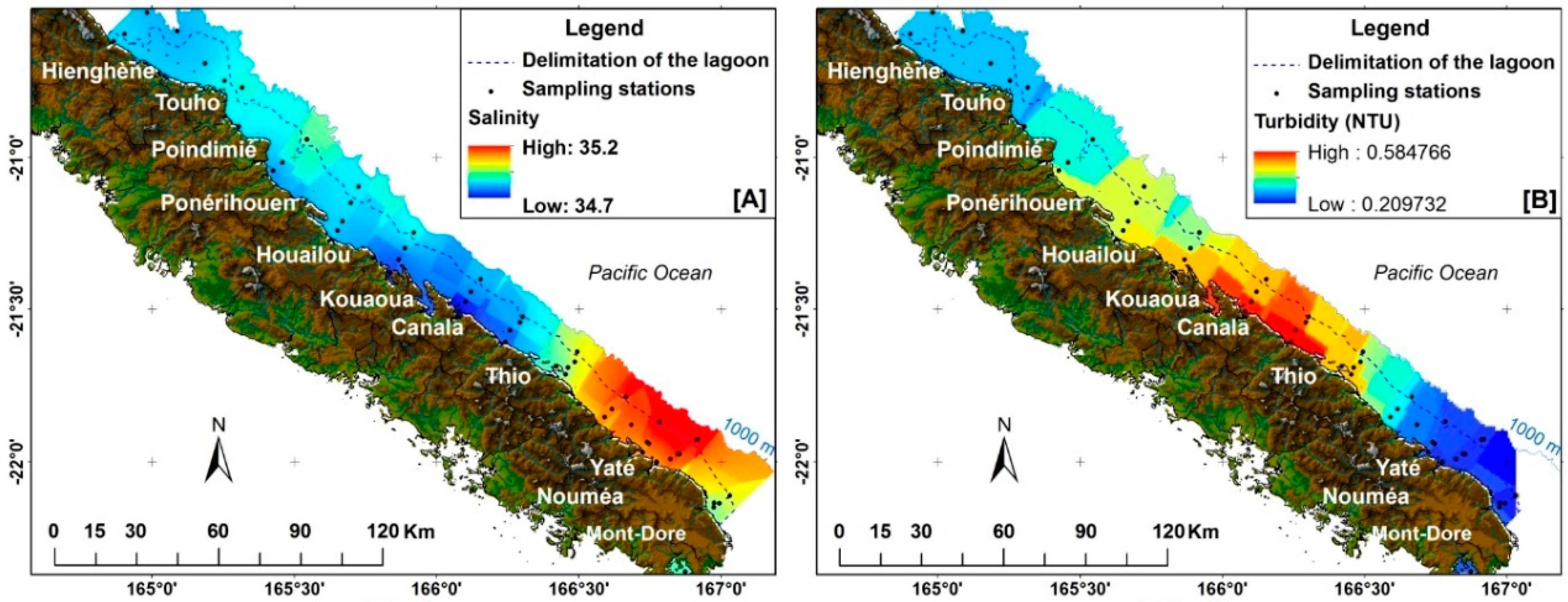
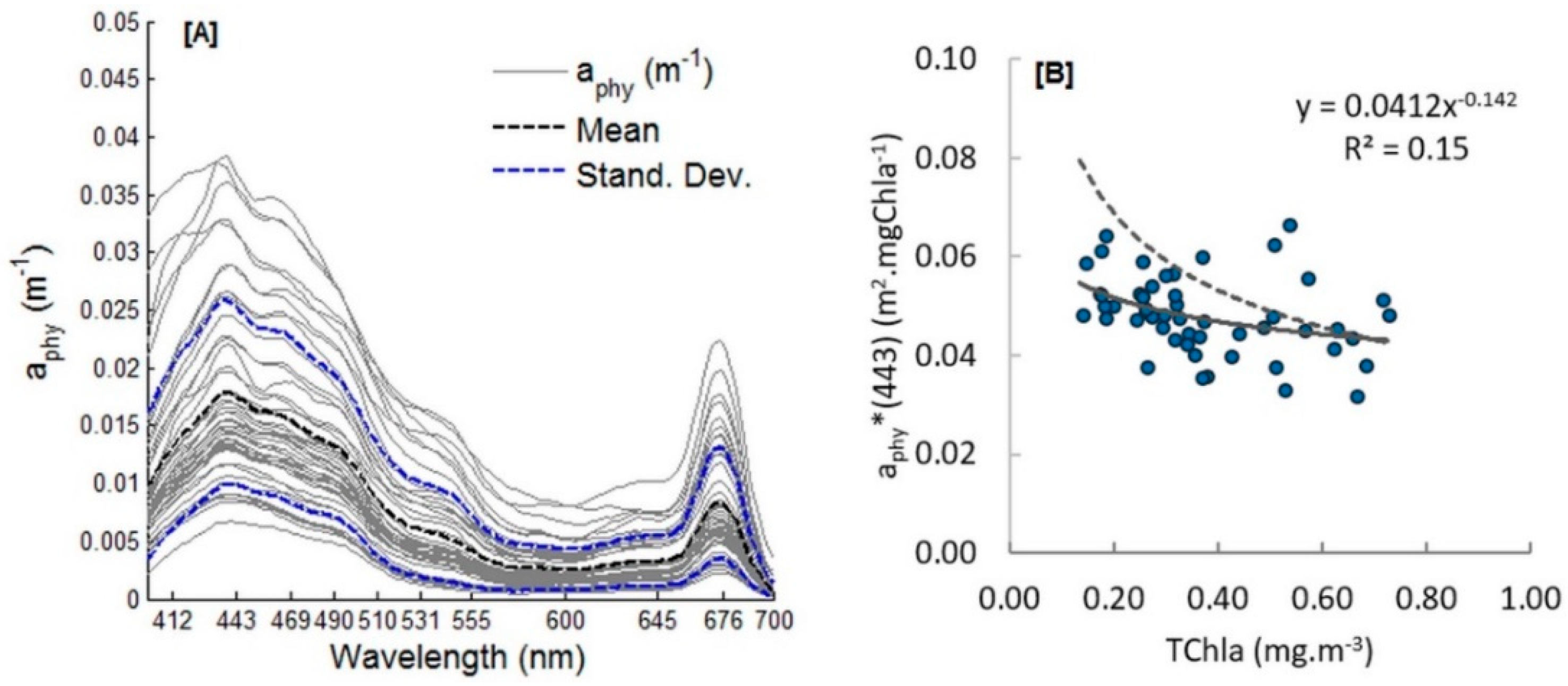
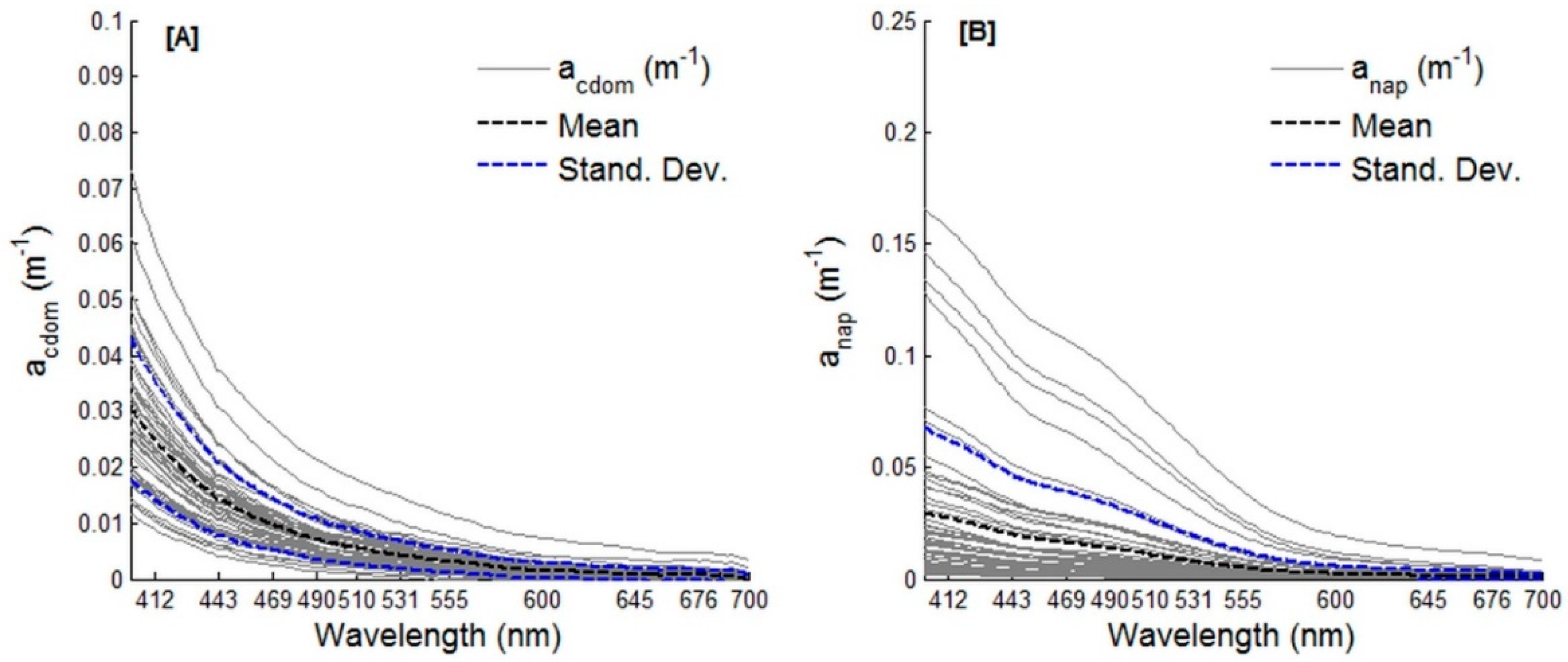
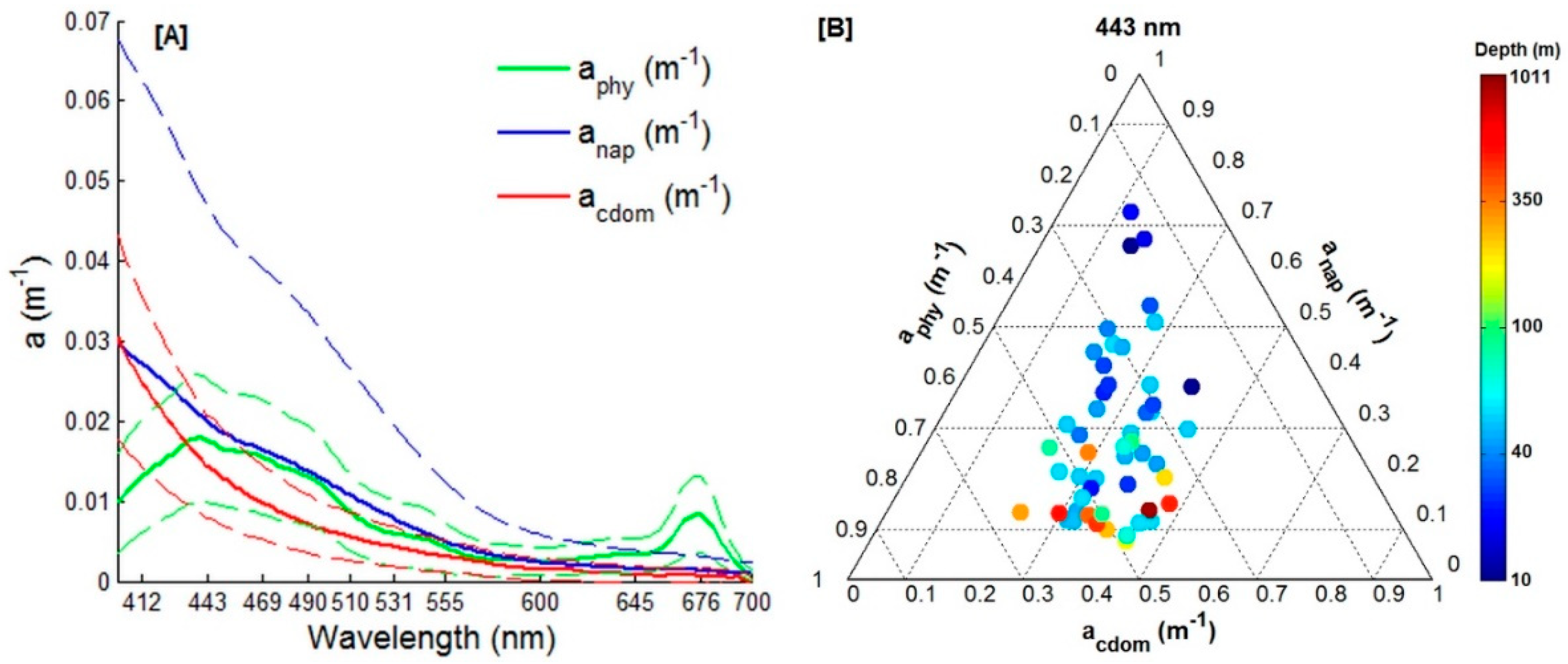
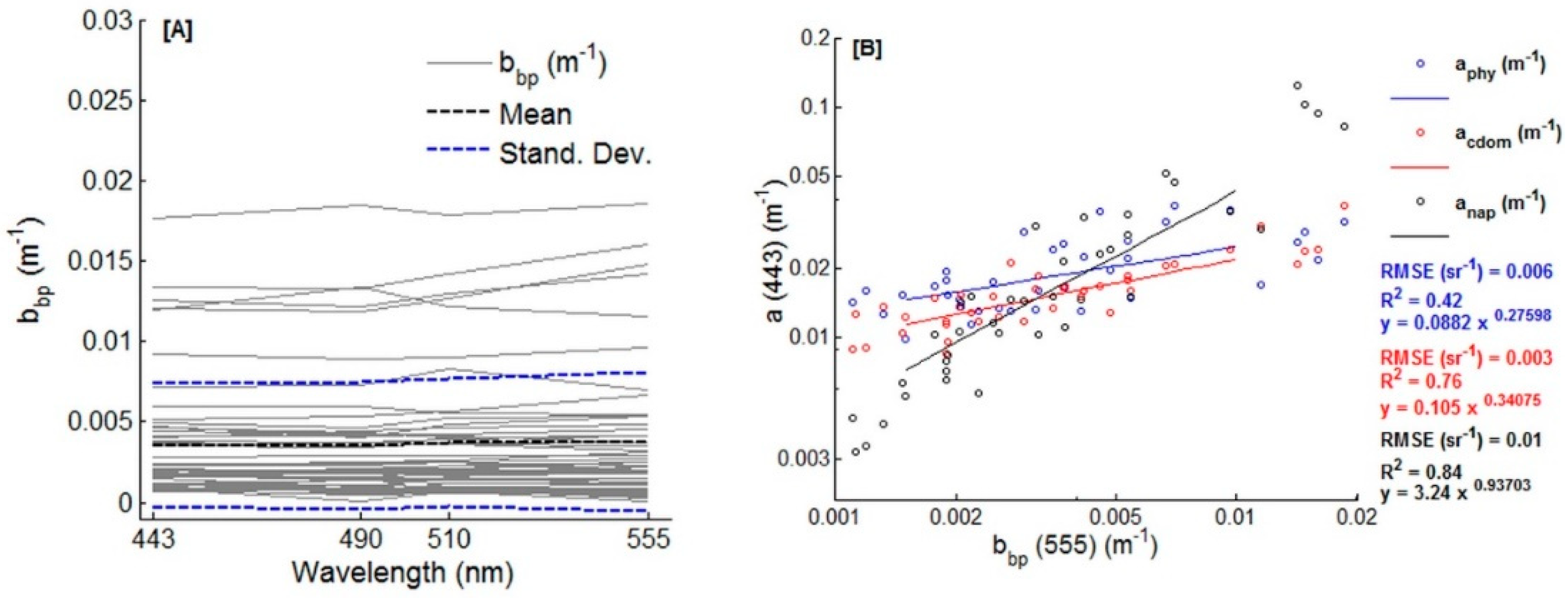
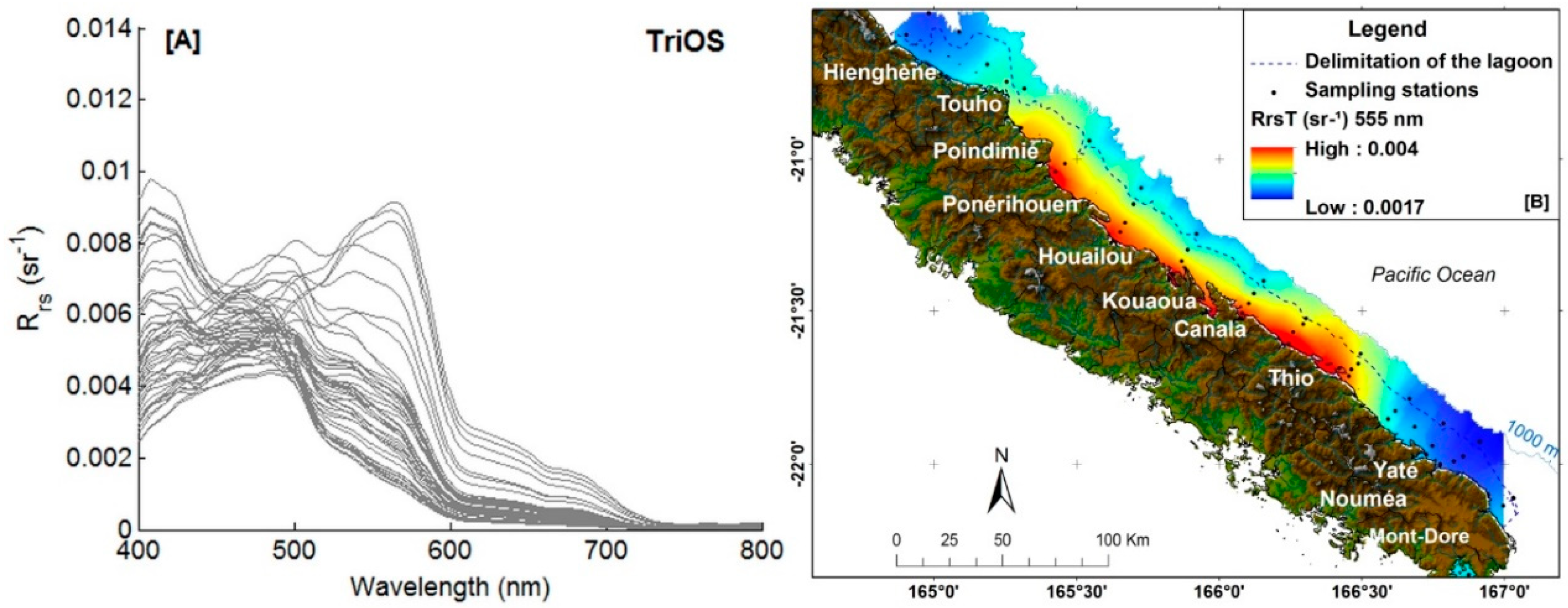
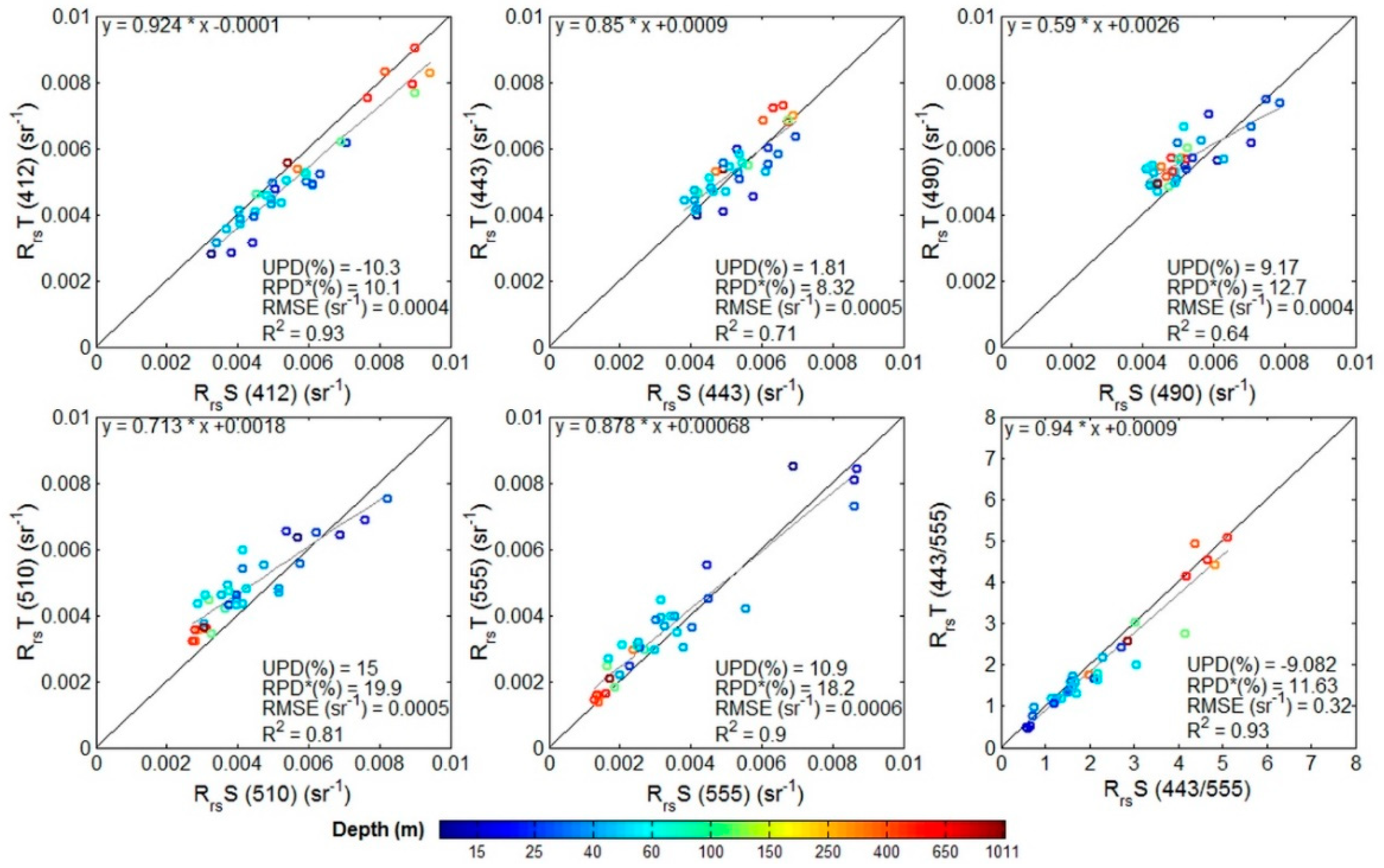

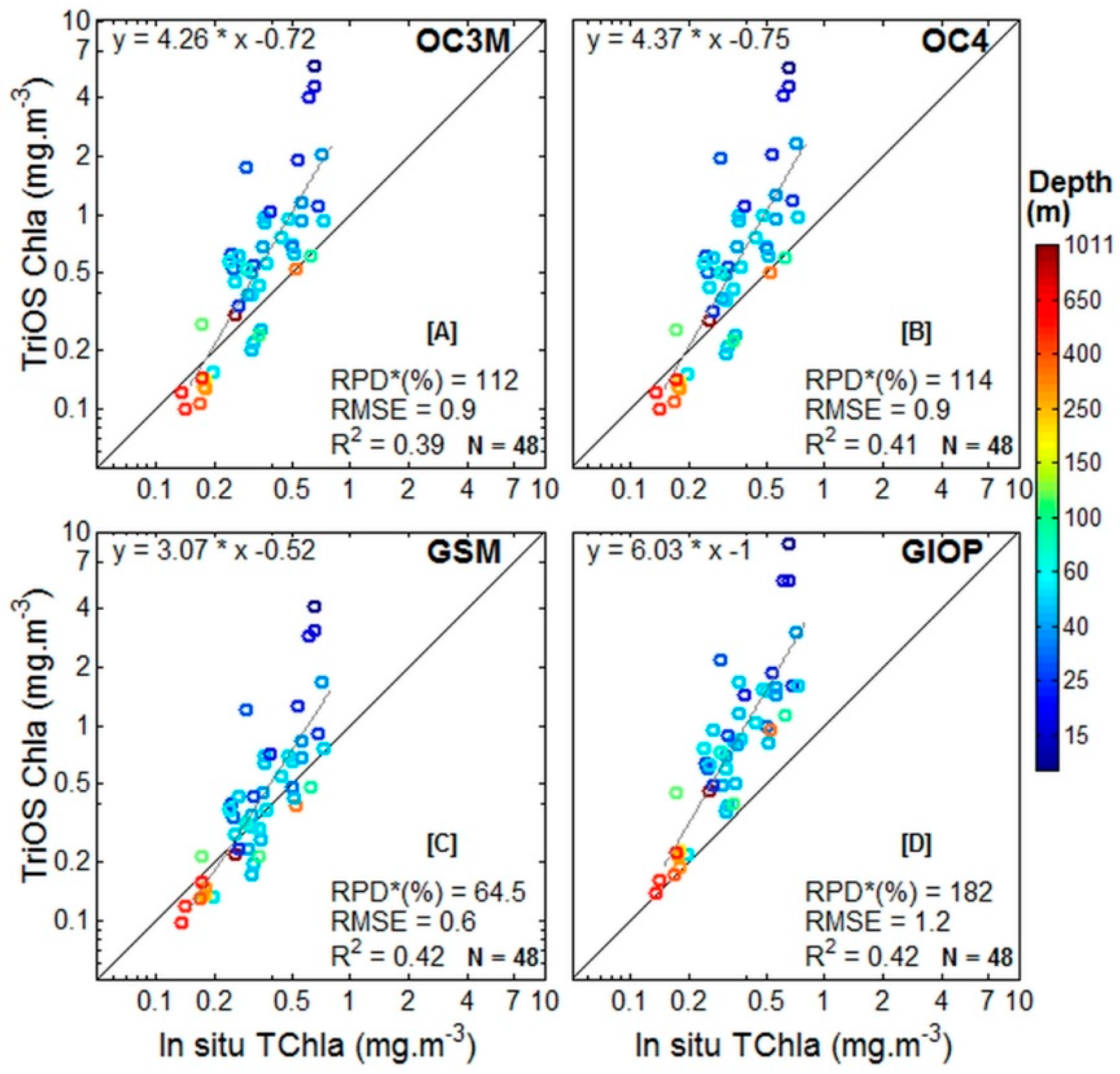
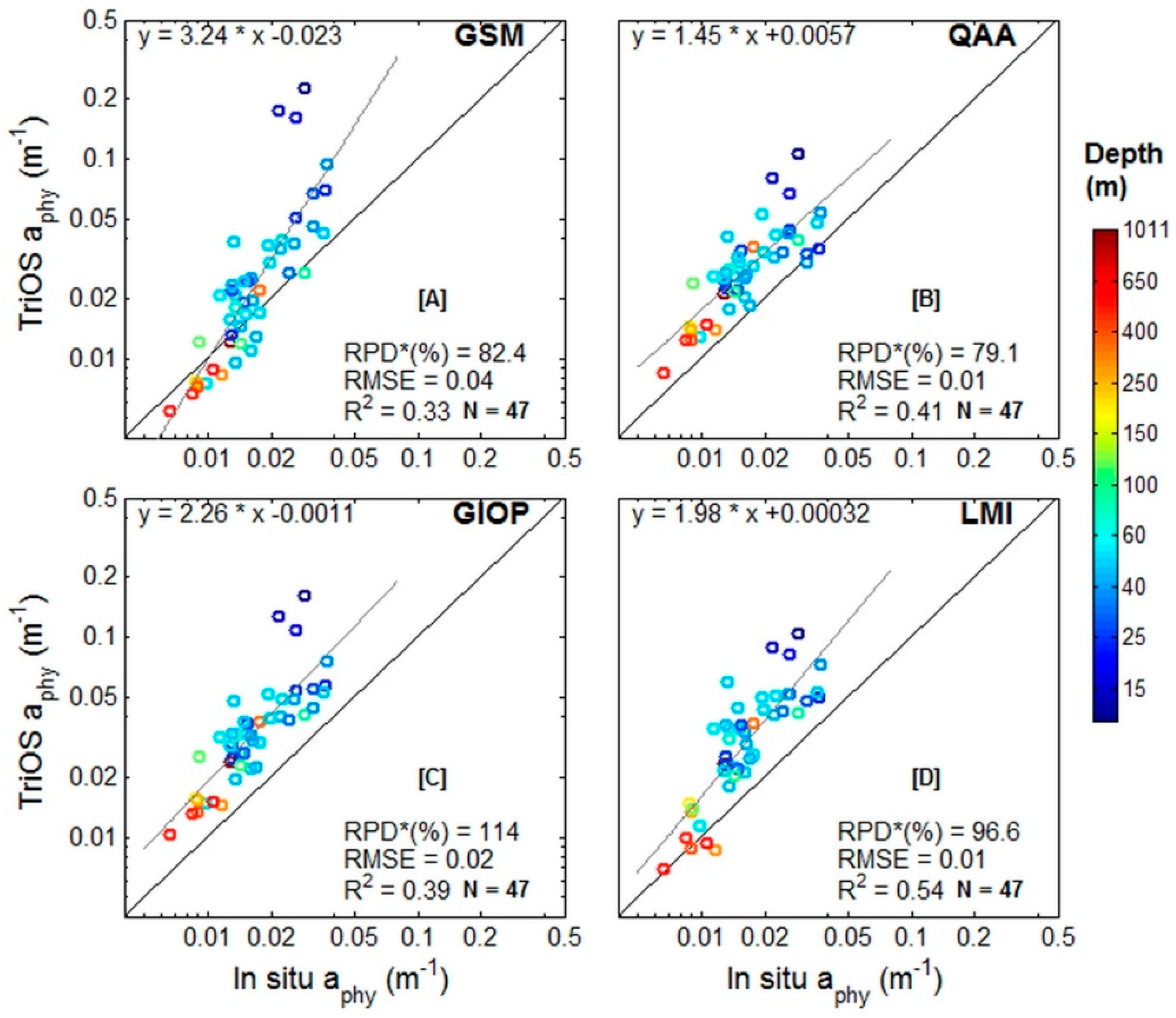
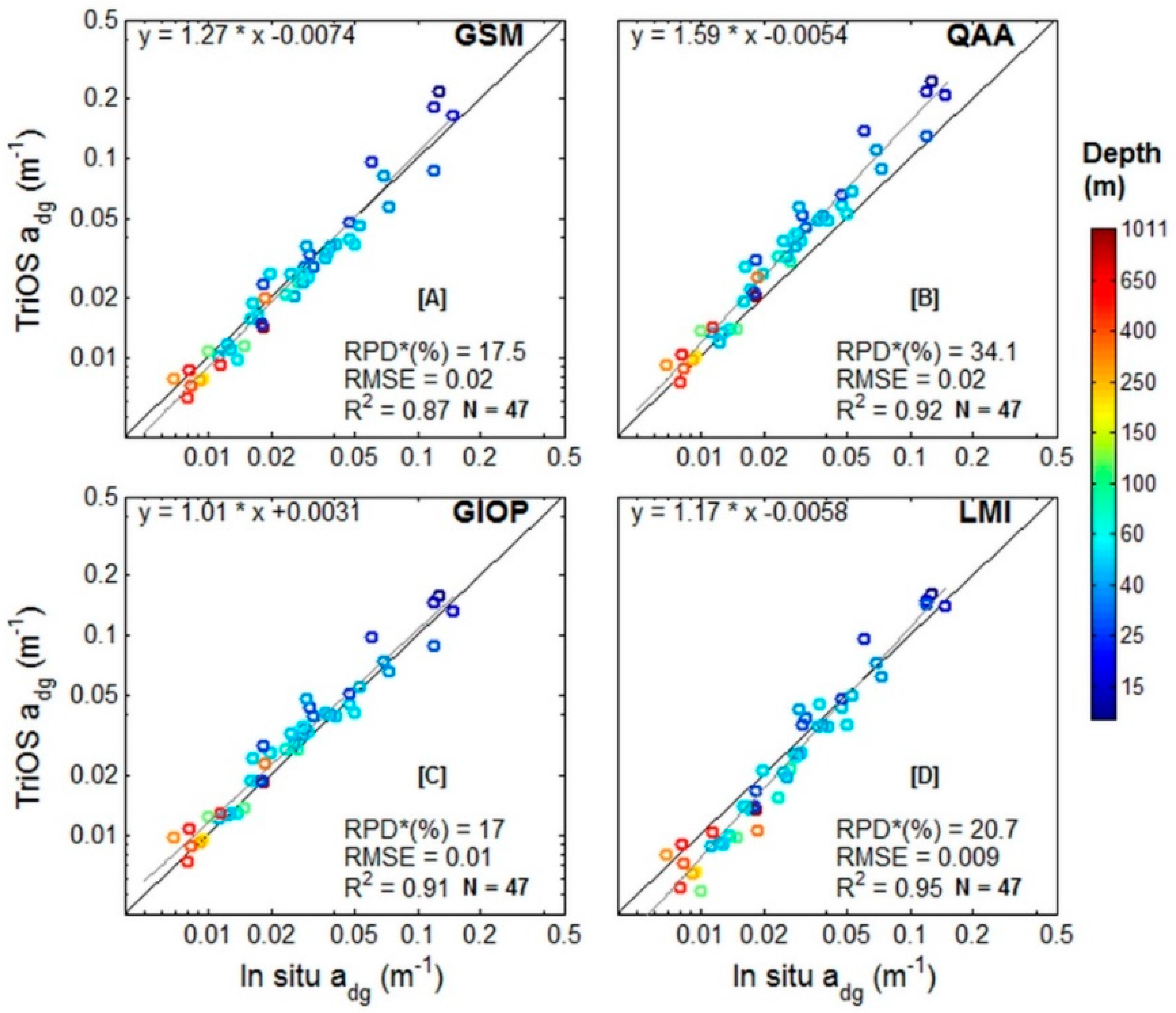
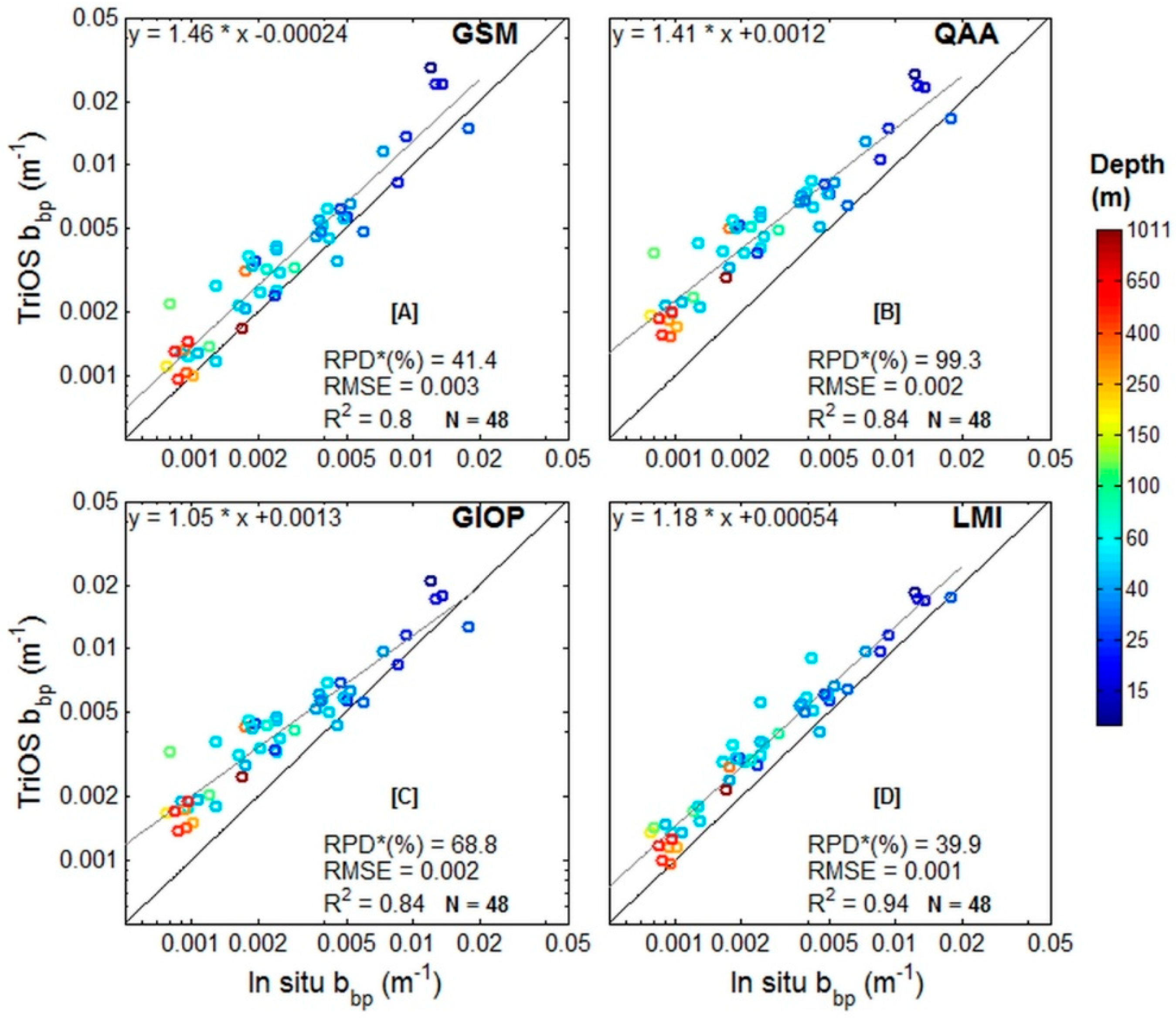
© 2018 by the authors. Licensee MDPI, Basel, Switzerland. This article is an open access article distributed under the terms and conditions of the Creative Commons Attribution (CC BY) license (http://creativecommons.org/licenses/by/4.0/).
Share and Cite
Favareto, L.R.; Rudorff, N.; Kampel, M.; Frouin, R.; Röttgers, R.; Doxaran, D.; Murakami, H.; Dupouy, C. Bio-Optical Characterization and Ocean Colour Inversion in the Eastern Lagoon of New Caledonia, South Tropical Pacific. Remote Sens. 2018, 10, 1043. https://doi.org/10.3390/rs10071043
Favareto LR, Rudorff N, Kampel M, Frouin R, Röttgers R, Doxaran D, Murakami H, Dupouy C. Bio-Optical Characterization and Ocean Colour Inversion in the Eastern Lagoon of New Caledonia, South Tropical Pacific. Remote Sensing. 2018; 10(7):1043. https://doi.org/10.3390/rs10071043
Chicago/Turabian StyleFavareto, Luciane Rafaele, Natália Rudorff, Milton Kampel, Robert Frouin, Rüdiger Röttgers, David Doxaran, Hiroshi Murakami, and Cécile Dupouy. 2018. "Bio-Optical Characterization and Ocean Colour Inversion in the Eastern Lagoon of New Caledonia, South Tropical Pacific" Remote Sensing 10, no. 7: 1043. https://doi.org/10.3390/rs10071043
APA StyleFavareto, L. R., Rudorff, N., Kampel, M., Frouin, R., Röttgers, R., Doxaran, D., Murakami, H., & Dupouy, C. (2018). Bio-Optical Characterization and Ocean Colour Inversion in the Eastern Lagoon of New Caledonia, South Tropical Pacific. Remote Sensing, 10(7), 1043. https://doi.org/10.3390/rs10071043





